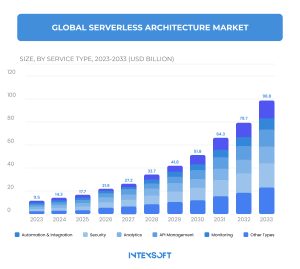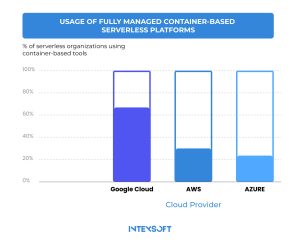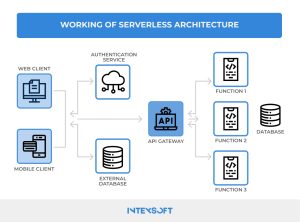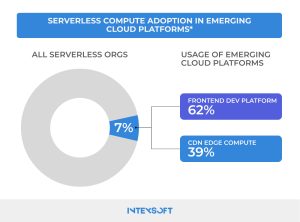
This article unpacks the technical and economic realities of serverless, examining its impact on modern development. We highlight industry leaders, explore real-world use cases, and consider what serverless means for the future of cloud computing. Contact us for deeper insights.
Reading time: 17 min.
Serverless architecture isn’t actually “serverless.” The name is misleading—there’s still a server somewhere, crunching data and keeping applications running. But here’s the difference between server and serverless architecture: in a traditional server-based model, companies own, rent, and manage physical or virtual servers, handling everything from maintenance to scaling. In contrast, serverless architecture offloads that responsibility to cloud providers. Developers don’t have to provision hardware, scale infrastructure, or worry about capacity planning. They write the code, and the cloud handles the rest.
The model flips the traditional approach on its head. Instead of renting servers by the hour or committing to fixed storage plans, companies pay only for the computing power they actually use. There are no idle servers and no wasted resources. Just execution, on demand.
Look at the statistics below that illustrate all the optimistic rises in the industry:

Amazon’s AWS Lambda, Microsoft’s Azure Functions, Google Cloud Functions, and IBM’s OpenWhisk are leading the charge.

These platforms let developers deploy code, process data, and build backend applications without touching a single server. Event-driven triggers fire functions only when needed—whether it’s processing an image upload, handling API requests, or running scheduled tasks. The result? More efficiency, fewer operational headaches, and a faster path from idea to deployment.
IntexSoft breaks it down. Let’s get into it.
| Advantage | Explanation |
| No Infrastructure Management | No need to configure or maintain servers, reducing operational overhead. Useful for startups and small teams. |
| Scalability Without Effort | Applications scale automatically based on demand, eliminating manual resource provisioning. |
| Cost Efficiency (In the Right Context) | Pay-per-execution model ensures payment only for actual compute time used, making it cost-effective for sporadic workloads. |
| Faster Time to Market | Developers can focus on code rather than infrastructure, leading to faster deployment and innovation. |
| Built-in High Availability | Cloud providers handle redundancy and failover mechanisms, reducing downtime risks. |
| Disadvantage | Explanation |
| Cold Starts and Latency Issues | Functions that haven’t been used recently can introduce delays upon execution, impacting performance-sensitive applications. |
| Vendor Lock-in Is Real | Applications become dependent on a single cloud provider, making migration difficult. |
| Debugging Is Harder | Limited access to logs and runtime behavior makes troubleshooting and debugging more complex. |
| Not Always Cost-Effective | Continuous, high-volume workloads may be more expensive compared to traditional infrastructure. |
| Security and Compliance Concerns | Companies must rely on cloud providers for security measures, which may pose risks for compliance-heavy industries. |
Serverless architecture is a tool that fits some use cases exceptionally well but fails others. For startups racing to deploy a product, it’s a gift. Enterprises with complex, always-on workloads? Maybe not.
The appeal is obvious: reduced infrastructure management, built-in scalability, and pay-as-you-go pricing. But beneath the surface, serverless comes with trade-offs—cold starts, vendor lock-in, and limited control. The promise of simplicity can be misleading. The real question is whether its advantages outweigh its limitations in your case.
At IntexSoft, we cut through the noise to help businesses make choices that work in practice. Serverless might be the right move, or it might not. The key is expert consultation before you commit.
As we have mentioned above, the term serverless is misleading. The servers exist—but they’re not yours to manage, not yours to maintain. The cloud provider owns them, operates them, and decides how they run. Your only job? Writing the code.
Here’s how it unfolds:

Serverless architecture isn’t just another cloud computing trend—it’s a fundamental shift in how software is built, deployed, and scaled. The old way? Companies had to provision servers, manage capacity, and keep an eye on infrastructure 24/7. The new way? Offload all of that to cloud providers and focus entirely on writing code.
At its core, serverless computing relies on six key components: Function as a Service (FaaS), client interface, cloud-based web server, security service, backend database, and an API gateway. Each piece plays a role in eliminating the headaches of traditional infrastructure, allowing developers to do what they do best—build.
Why does this matter? Because businesses no longer need deep pockets or massive IT teams to create scalable, high-performance applications. Serverless levels the playing field. A small startup can now harness the same computing power as a Fortune 500 company without the burden of maintaining physical servers. The model is simple: write code, deploy it, and let the cloud handle the rest.
Three major benefits stand out:

Something changed in how the web is built. The old way—monolithic applications, full-stack developers managing both front and backends—started to look sluggish, bloated, and unnecessary. In its place, a new model took shape: frontend-driven applications powered by API-driven backends. And at the center of this shift? Serverless architecture.
The idea is simple: let the frontend handle the user experience, while the backend exists only as modular, on-demand services. No traditional servers. No tightly coupled databases. Just lightweight applications that communicate with APIs when needed.
This approach, paired with serverless computing, means developers don’t need to manage infrastructure. They don’t set up backend servers, scale databases, or worry about load balancing. Instead, cloud functions—small pieces of backend logic—execute only when called. An authentication request? A cloud function handles it. A form submission? Another function spins up, processes the request, and disappears.
In this new model, backends aren’t static machines. They’re fluid—collections of APIs stitched together to provide functionality. Authentication comes from Auth0, payments from Stripe, and content from headless CMSs like Contentful or Sanity. Each service operates independently, responding only when needed.
This API-driven approach shifts the focus. Frontend developers, once constrained by backend limitations, now have direct access to powerful, scalable services. They build faster. Deploy faster. Iterate faster. The frontend isn’t waiting for the backend team to provision a server—it simply calls an API and gets what it needs.
There are giants that hold the keys: Amazon, Google, and Microsoft. Their platforms—AWS Lambda, Google Cloud Functions, and Microsoft Azure Functions—define the rules. If you build in their ecosystem, you play by their terms.
Each provider has its own strengths, its own way of operating. And whether you’re a developer, a CTO, or a company betting its future on cloud technology, knowing how these platforms work is truly essential.
Amazon was first to the party. In 2014, AWS Lambda introduced the world to the idea that code could execute on demand—no servers to manage, no provisioning to worry about. Just functions running when needed, triggered by events.
Lambda is deeply embedded in the AWS ecosystem. It’s built to work seamlessly with S3, DynamoDB, API Gateway, and Step Functions—all of Amazon’s services. If your infrastructure is AWS-heavy, Lambda feels like home.
And speaking of cost—Lambda’s pay-per-execution model is a blessing for small workloads, but for high-frequency applications, the bills add up fast.
Google came later, but it brought its own strengths. Google Cloud Functions is engineered for speed, lightweight deployment, and deep integration with Google’s AI and analytics services.
The biggest advantage? Cold starts—or the lack of them. Google has optimized its function execution to start faster than Lambda, particularly in Node.js and Python. And it’s not just about serverless functions. Google is pushing an entire event-driven model where Cloud Functions interact with Firebase, BigQuery, and Pub/Sub, making it a natural fit for real-time apps, AI processing, and data-heavy workloads.
Microsoft isn’t chasing startups. It’s not targeting hobbyists. Azure Functions is built for enterprises—companies already running .NET, Windows Server, and Active Directory. If your company lives in the Microsoft ecosystem, Azure Functions is a natural extension.
Where Azure shines is in its support for stateful serverless functions. Most serverless platforms force you to work stateless—each function starts and ends without memory of previous executions. Azure Functions, however, offers Durable Functions, allowing complex workflows that can retain state between executions.
Hybrid cloud? Azure has the best story there. While AWS and Google want you in their cloud, Microsoft understands that many enterprises still have on-premise data centers. Azure Functions integrates smoothly with legacy infrastructure, bridging the old world with the new.
Stripping away the burden of in-house infrastructure, IntexSoft‘s client companies redirected their focus to what mattered—building, innovating, and scaling without the usual constraints. Costs dropped. Development accelerated. Agility became the standard, not the exception.
Here’s what that looked like in practice. Let’s look at some examples. For more details, you can refer to the links below.
A marketing agency in Europe faced a digital conundrum. Their social media operations were fragmented, their analytics rudimentary, and the manual effort required to manage multiple platforms was eating into their resources. They needed a system that would centralize their workflow, automate content scheduling, and provide real-time insights.
We found the answer. It became not just another SaaS tool—it was a serverless architecture designed to be lean, scalable, and intelligent.
IntexSoft engineered a serverless social media management platform that married automation with AI-driven insights. The platform seamlessly integrated with various social networks, offering:
Built on a cloud-native architecture, this platform could handle fluctuations in demand seamlessly, eliminating the need for costly infrastructure maintenance. AI and ML fueled engagement optimization, ensuring content reached the right audience at the right time.
For an AI-driven data processing firm, efficiency was non-negotiable. They needed a solution that could extract, store, and structure vast amounts of product data from multiple online stores. Their existing framework lacked the robustness required for large-scale web scraping.
IntexSoft rebuilt the framework from the ground up. Using Selenium, the team optimized the collection process for Single-Page Applications (SPAs). We integrated an API that enabled on-demand product data updates and real-time status tracking for scrapers. Key enhancements included:
This was more than a technical upgrade—it was a complete transformation of how the client handled product data, allowing them to process thousands of updates without infrastructure strain.
From a mobile app for tourists to an innovative car parking app, our use cases showcase the power of serverless. Want to see how it could work in your industry? Contact our experts—they’ll help you uncover real opportunities.
| Challenge | The Reality Behind It |
| Stateless Limitations | Serverless functions don’t remember past executions. Every run is a fresh start. Need continuity? You’re stuck bolting on external databases or caching systems, adding complexity and cost. |
| Cold Start Delays | Functions vanish when idle. When a new request comes in, the system has to spin up a new instance—sometimes in seconds. Fine for batch jobs, but a dealbreaker for real-time apps. |
| Scaling Isn’t Infinite | Providers promise “infinite scalability,” but in reality, every service has limits—execution time caps, memory constraints, and concurrency throttling. Hit those walls, and your system stalls. |
| Vendor Lock-In | Lambda is built for AWS, Google Cloud Functions love Firebase, Azure Functions live inside Microsoft’s ecosystem. The deeper you go, the harder it is to leave. |
| Observability Black Hole | You can’t just SSH into a server and see what’s happening. Debugging means wading through fragmented logs and tracing errors across multiple services—hoping you find the issue before it spirals. |
| Security Complexity | No servers to manage doesn’t mean no security concerns. Permissions, API gateways, and data access need to be locked down, or you risk breaches from misconfigured settings. |
Cold start delays leave users waiting. Vendor lock-in forces tough decisions down the road. And when things break, debugging in a fragmented, ephemeral environment becomes a battle against the unknown.
Then there’s the stateless nature of serverless functions—a fundamental design constraint that complicates anything requiring persistent data. Workarounds exist, but they add layers of complexity.
The road ahead? Engineers and researchers are working to smooth out these rough edges, but the reality is clear: serverless is a tool—one that demands a deep understanding of its trade-offs before going all in.
Understanding the pros and cons of serverless architecture is important before making the leap. The advantages of serverless architecture are clear: reduced operational overhead, automatic scaling, and cost efficiency. But there are trade-offs—cold start delays, vendor lock-in, and debugging complexity that can create new challenges if not carefully managed.
So how to build serverless architecture that works? It thrives in microservices-based environments, where monolithic applications are broken into independent, event-driven components. Companies leveraging serverless often use it for MVPs, IoT applications, webhooks, media processing, and AI-powered chatbots—workloads that demand agility and automation.
Want to future-proof your infrastructure? IntexSoft’s experts can show you how.